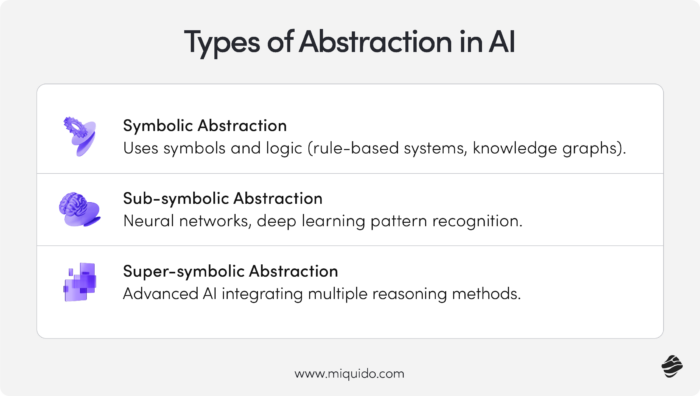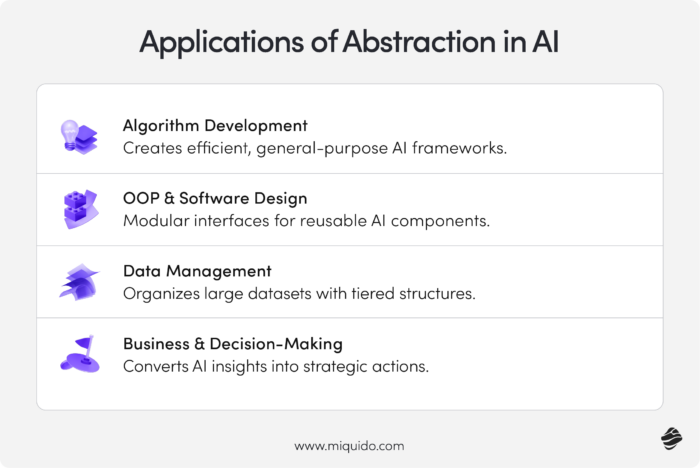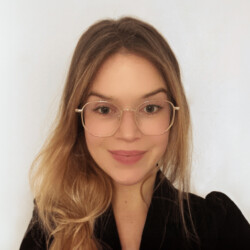

Abstraction in AI Definition
What is Abstraction in AI?
Abstraction in AI simplifies complexity by focusing on essential features and hiding irrelevant details, aiming to replicate aspects of human intelligence and the decision-making processes of human beings. This technique helps AI mimic human-like perception, knowledge representation, reasoning, and learning. It’s widely used in problem-solving, theorem proving, spatial and temporal reasoning, and machine learning development.
Key Components of Abstraction in AI
Abstraction in AI involves several key components:
- Simplification: This reduces complexity by emphasizing important features and ignoring non-essential details.
- Interfaces: Abstraction creates interfaces that mask implementation details, enhancing robustness and maintainability.
- Core Knowledge: Abstraction leverages innate human-like core knowledge for learning and reasoning, as seen in the Abstraction and Reasoning Corpus (ARC).
A machine learning algorithm plays a crucial role in automating the evaluation of literature and clinical imaging data, thereby improving diagnostic accuracy and efficiency.
The structure and function of AI systems often draw inspiration from the human brain, particularly in how neural networks mimic the interconnectivity of neurons.
The Abstraction and Reasoning Corpus (ARC)
The ARC, introduced by François Chollet, is a benchmark designed to measure AI's ability to learn and reason with human-like core knowledge. It consists of tasks solvable by both humans and machines, requiring abstract reasoning to identify patterns and generate correct outputs. The ARC challenges AI systems to solve various tasks using minimal prior knowledge, aiming to advance general artificial intelligence.
Benefits of Abstraction in AI
Abstraction in AI offers several benefits. Deep learning algorithms, which process and analyze large volumes of unstructured data, benefit significantly from abstraction techniques. It streamlines complex problems by filtering out extraneous details and enhances AI’s ability to recognize patterns and make effective predictions. By simplifying interfaces, it democratizes AI technology, making it accessible to developers without deep technical knowledge. Additionally, abstraction helps AI handle uncertainty and apply general principles to new situations, similar to learning from experience.
Types of Abstraction in AI
There are several distinct forms of abstraction used in AI, each serving a unique purpose in knowledge representation and learning.

1. Symbolic Abstraction
- Uses symbols and logic-based representations to model objects and relationships.
- Commonly found in rule-based systems and knowledge graphs.
2. Sub-symbolic Abstraction
- Relies on statistical and neural network-based models that encode information implicitly.
- Examples include deep learning models that recognize patterns in images and text.
3. Super-symbolic Abstraction
- Involves higher-level conceptualizations that transcend traditional symbolic and sub-symbolic representations.
- Used in advanced AI models that integrate multiple reasoning mechanisms.
Applications of Abstraction in AI
Abstraction plays a crucial role in numerous AI applications, improving efficiency, scalability, and problem-solving capabilities.

1. Algorithm Development
- Helps design efficient algorithms by abstracting away problem-specific details.
- Allows for the creation of general-purpose AI frameworks.
2. Object-Oriented Programming (OOP)
- Uses abstraction to hide implementation details behind modular interfaces.
- Enables the development of reusable and maintainable AI software components.
3. Database Tiering and Data Management
- Structures data into layers of abstraction to facilitate efficient storage and retrieval.
- Enhances the organization and processing of large-scale AI datasets.
4. Computational Complexity Reduction
- Simplifies problem-solving approaches in areas such as theorem proving and constraint satisfaction.
- Helps AI models operate within realistic computational constraints.
AI in Business, Decision-Making, and Pattern Recognition
- Abstracts complex AI concepts into actionable insights for business leaders.
- Aids in strategy formulation by analyzing key data patterns and trends.
Challenges and Future Research Directions
Despite its benefits, abstraction in AI faces several challenges. It can be computationally expensive, especially for high-resolution tasks, and AI systems may struggle with generating coherent outputs for unseen data. Balancing abstraction and system performance requires careful consideration. Future research aims to address these challenges and further enhance the capabilities of AI systems.
Abstraction in AI is a crucial technique that simplifies complex systems, enhances efficiency, and improves pattern recognition. By focusing on essential elements, AI systems can operate more effectively and adapt to various applications, driving advancements in and other domains.
Ready to discover more terms?








